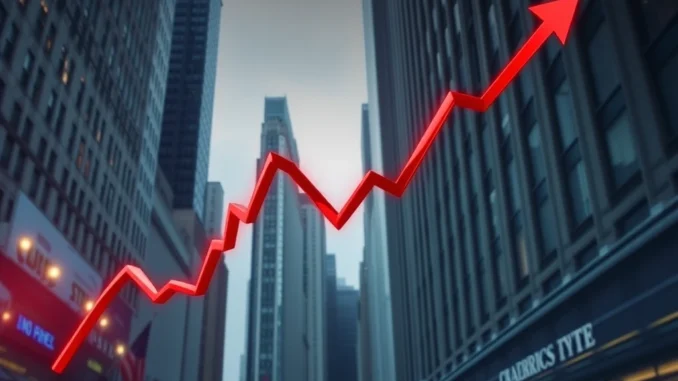
Worried about the recent dips in the crypto market? Well, traditional markets aren’t immune either. Today, U.S. stock markets took a significant hit, closing notably lower. For those tracking economic trends and investment landscapes, this stock market downturn signals more than just red numbers on a screen. Let’s break down what happened and what it might mean for your broader investment strategy.
Understanding the Stock Market Downturn: Key Indices in Red
The closing bell rang with a clear message: Wall Street is feeling the pressure. All major U.S. stock market indices ended the day in negative territory. Here’s a quick snapshot:
- S&P 500: Down by 1.39%
- NASDAQ Composite: Fell by a steeper 1.96%
- Dow Jones Industrial Average: Decreased by 1.30%
These numbers aren’t just figures; they represent billions of dollars in market value erased in a single day. But what triggered this widespread selling pressure? Let’s delve into the potential economic indicators at play.
Decoding the Downturn: What Economic Indicators Are We Watching?
Several factors could be contributing to this bearish sentiment in the stock market. While we need more data to pinpoint the exact causes, here are some potential economic indicators that are often closely linked to stock market performance:
- Inflation Concerns: Persistent inflation can erode purchasing power and prompt central banks to adopt tighter monetary policies, which can be a headwind for stock valuations.
- Interest Rate Hikes: Anticipation or actual increases in interest rates can make borrowing more expensive for companies and reduce the present value of future earnings, impacting stock prices negatively.
- Geopolitical Uncertainty: Global events and geopolitical tensions can introduce volatility and risk aversion in the markets, leading investors to pull back from stocks.
- Corporate Earnings Outlook: If the outlook for corporate earnings growth dims, investors may become less willing to pay high prices for stocks.
- Consumer Spending Data: Weaker-than-expected consumer spending data can signal a potential slowdown in economic growth, impacting company revenues and investor confidence.
It’s crucial to monitor these economic indicators closely in the coming days and weeks to better understand the underlying reasons for this market pullback and anticipate potential future movements.
Investment Losses Mount: Navigating a Volatile Market
For investors, days like these can be unsettling. Seeing portfolios shrink due to broad market declines is never easy. The immediate impact is clear: investment losses are realized across various sectors. However, it’s essential to keep a long-term perspective and avoid panic selling.
Here are a few actionable insights for investors during periods of market volatility:
- Stay Calm and Avoid Emotional Decisions: Market downturns are a part of the investment cycle. Emotional reactions can lead to poor decisions.
- Review Your Portfolio: Assess your asset allocation and diversification. Is your portfolio aligned with your risk tolerance and long-term goals?
- Consider Dollar-Cost Averaging: Investing a fixed amount of money at regular intervals, regardless of market fluctuations, can be a strategy to mitigate risk over time.
- Look for Opportunities: Market corrections can present opportunities to buy quality assets at lower prices. Conduct thorough research before making any investment decisions.
- Seek Professional Advice: If you’re unsure about how to navigate the current market environment, consult with a financial advisor.
In-Depth Market Analysis: Beyond the Headlines
To truly understand the implications of today’s market close, a deeper market analysis is required. Simply looking at the percentage drops doesn’t tell the whole story. We need to consider:
- Sector Performance: Which sectors were hit the hardest? Were there any sectors that outperformed the overall market? Understanding sector-specific trends can provide valuable insights.
- Trading Volume: Was the selling pressure accompanied by high trading volume? Increased volume during a downturn can indicate stronger conviction among sellers.
- Market Breadth: How many stocks participated in the decline? A broad-based decline, where a large number of stocks are falling, is generally considered more concerning than a decline concentrated in a few names.
- Technical Analysis: Examining chart patterns and technical indicators can offer clues about potential support and resistance levels, and the overall market trend.
A comprehensive market analysis should incorporate both fundamental and technical factors to provide a well-rounded view of the market’s health and potential future direction.
Stock Market News and the Crypto Connection
Why should cryptocurrency enthusiasts care about traditional stock market news? The answer lies in the increasing interconnectedness of global financial markets. While crypto operates in its own ecosystem, it’s not entirely isolated from traditional finance. Here’s why this news matters to you:
- Risk Sentiment Spillover: A risk-off sentiment in the stock market can often spill over into the crypto market. When investors become more risk-averse, they tend to reduce exposure to both stocks and cryptocurrencies, which are often perceived as riskier assets.
- Macroeconomic Influences: The same macroeconomic factors that impact the stock market (inflation, interest rates, economic growth) can also influence the crypto market.
- Institutional Investment: Increasing institutional investment in both crypto and traditional markets means that these markets are becoming more correlated. Actions of large institutional investors can impact both asset classes.
- Economic Health Indicator: The performance of the stock market is often seen as a barometer of overall economic health. A significant and sustained downturn in the stock market could signal broader economic challenges that might eventually affect the crypto space as well.
Navigating Market Uncertainty: A Summary for Investors
Today’s lower close in U.S. stock markets serves as a stark reminder of market volatility and the ever-present risks in the investment world. The stock market downturn, fueled by a complex interplay of economic indicators, has led to notable investment losses. While the immediate impact is concerning, it’s crucial to approach these situations with a calm and informed perspective. Conducting thorough market analysis and understanding the broader economic context are vital for making sound investment decisions. And for those in the crypto space, paying attention to traditional stock market news offers valuable insights into overall market sentiment and potential ripple effects. Remember, market fluctuations are normal. Staying informed, maintaining a long-term strategy, and seeking professional advice when needed are your best tools for navigating these uncertain times and emerging stronger on the other side.



